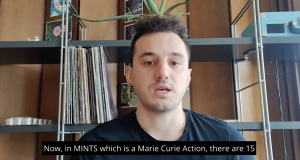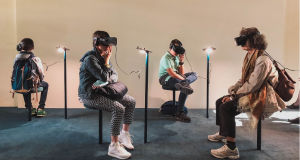Published on: Dec 28, 2020
Welcome to Part 3 of our MINTS 101 series where we discuss the different technical aspects of the MINTS project. Part 1 and Part 2 of the series have covered the basics of mmWave technology and the various applications. In this post, we talk about 5G – the fifth generation of mobile telecommunications and its benefits.
Evolution of mobile telephony
Let’s start by discussing the different generations of mobile telephony. We have all heard the terms 3G, 4G and 5G, but what do they mean? To answer this, we need to go back to the 1980s when the first cell phone was introduced. This first generation of mobile technology was analog. We then moved on to digital wireless telephony with 2G which fell under the Global System for Mobile Communications (GSM). Later, this was integrated with the 3rd Generation Partnership Project (3GPP), the standardization body that deals with a comprehensive description of everything needed for a cellular technology to function [1]. 2G, as some older audiences may remember, was a time when mobile phones only supported calls and minimal texting. 2.5G introduced “data connectivity” as we refer to it today, but the data rate was very limited.

Fig.1 Evolution of mobile telephony from 1G to 5G [2]
The advent of 3G gave way to faster speeds allowing multimedia transmissions on mobile phones and data to browse, download and watch videos. To achieve this, 3G introduced Frequency Division Duplexing (FDD) and Time Division Duplexing (TDD) [1]. FDD is where the mobile device to base station link (uplink) and base station to mobile device link (downlink) are on different frequencies, thus avoiding interference. TDD, on the other hand, is where uplink and downlink use the same frequency but connect during different time slots. 4G LTE (Long term Evolution) is what our younger audience will relate with. It was a revolution in cellular technology using a time-frequency grid and OFDMA (Orthogonal Frequency Division Multiple Access) uplink and downlink that provides fast data rates and higher spectral efficiency. Ignoring the more technical terms, in simpler words we have moved from black and white texts to colourful videos and gifs, from limited bandwidth capabilities to a technology that is more efficient in terms of bandwidth usage.
What is 5G?
We now live in a time where we have millions of devices connected to each other and thus, we need a faster and more efficient network to maintain these connections without loss of data. 5G is the latest revolution in cellular technology that is better in terms of energy efficiency and spectral efficiency, offering increased reliability, low latency and support for IoT (Internet of Things). 5G, unlike previous generations, is not only limited to mobile phones but has use cases expanding to three main categories [2]:
-
Enhanced mobile broadband (eMBB): This covers increased data rates, especially in high-density scenarios. It is expected to also support high mobility scenarios with moving cars and even trains with a seamless network coverage.
-
Ultra-reliable and low latency communications (URLLC): This includes scenarios where it is expected to communicate without any loss of data or delays from the mobile to the base station. It is vital for applications where a slight lag may critically affect for instance a surgery, or in cases of mobility where a car/train (vehicle-to-everything, V2X) is connected to the network. Additionally, applications such as augmented reality (AR) are included where reliability and low latency are needed for optimal user experience.
-
Massive machine-type communications (mMTC): This is connected to IoT where millions of devices are connected to each other at all times. These are devices such as sensors or smart meters that consume very little power but are always on.
What to expect?
In the past year, we have heard about 5G deployments from telecommunication giants worldwide. We are promised peak data rates of 20 Gbit/s in downlink and 10 Gbit/s in uplink with peak spectral efficiencies: Downlink: 30 bit/s/Hz, Uplink: 15 bit/s/Hz. The latency is expected to be as low as 4 ms for eMBB and 1 ms for URLLC. Other specifications can be seen on the 3GPP website or in the latest Release 16 of June 2020 [1]. 5G will operate in multiple frequency bands but mobile communication will take place in the sub-6 GHz frequency band. As you may remember from our last blog, these are the frequencies between 800 MHz and 6 GHz. We expect possible movement to the mmWave frequency with further enhancements of 5G in the upcoming releases of 3GPP from V2X, Industrial IoT, satellite access and even mobile communication for railways.

Fig.2 Comparison of key capabilities of IMT-Advanced (4th generation) with IMT-2020 (5th generation) according to ITU-R (International Telecommunication Union- Radiocommunication Sector) [2]
3GPP has already licensed some mmWave bands for 5G between 24 – 100 GHz. As mentioned before, the main issue is the high level of attenuation and thus, mmWave has emerged as an indoor technology that should give enhanced data rates as good as a wired network. With base stations covering about a kilometer of distance, mmWave gives the possibility of dense coverage with a massive MIMO (huge >100 number of transmit and receive antennas) setup. mmWave will also offer faster data rates in closed environments such as stadiums, restaurants and even moving vehicles to each user thus surpassing any existing WiFi network. mmWave is much more useful in countries with densely populated areas and will increase the spectral efficiency in those regions. In the MINTS project, we are working on all the layers, from the physical layer to the application layer, to overcome these challenges in the deployment of mmWave networks.
If you were able to stick until the end and can’t wait for more content and want to know about us and our projects, you can always follow our social media channels.
Citations
[2] https://prc.chapters.comsoc.org/2019/04/01/5g-evolution-wireless-communications/
[3] https://www.etsi.org/technologies/mobile/
[4] M. Shafi et al., “5G: A Tutorial Overview of Standards, Trials, Challenges, Deployment, and Practice,” IEEE Journal on Selected Areas in Communications, vol. 35, no. 6, pp. 1201-1221, June 2017, doi: 10.1109/JSAC.2017.2692307.





